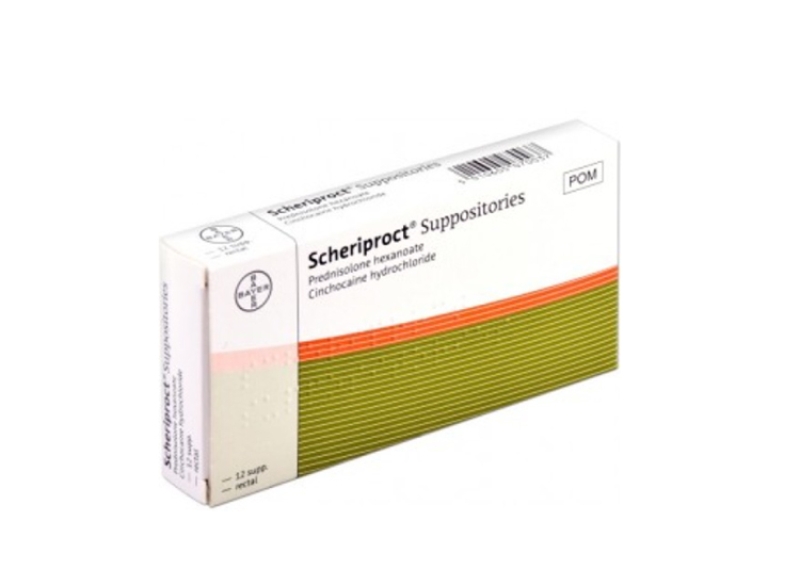Scheriproct Suppositories

* Images for illustrative purposes only
* Brand supplied may vary depending on stock availability
Same-day Service Available
Same-day service available for additional £10, conditions apply.

* Images for illustrative purposes only
* Brand supplied may vary depending on stock availability
Same-day service available for additional £10, conditions apply.
No appointment or long waiting times
Your information always remains private
All our doctors & pharmacists are qualified & based in the UK
Dispensed by our UK partner pharmacies


Choose from our treatment options or speak to the in-store pharmacist for advice

Complete our free online medical consultation to be reviewed by our Clinical Team

We will notify you when your medication is ready for collection
Scheriproct is an ointment especially made to cure external piles, haemorrhoids, and anal itching. The medication affords short term relief for 5 to 7 days for symptoms of haemorrhoids, pruritus and, proctitis, anal fissures, and itching of the anal area.
The Scheriproct ointment contains two leading ingredients; they are the Prednisolone and Cinchocaine. Cinchocaine is a local anaesthetic. It helps by essentially blocking away the pain messages sent on the nerve fibres. It helps numb the painful area where the medication has been applied thus affording quick relief from pain and or itching brought about by pruritus and, haemorrhoids, and anal fissures.
Prednisolone is a Corticosteroid and is utilised basically for preventing inflammation. They work by simply inhibiting cells from releasing some substances that can make blood vessels to expand and become irritated, swollen, itchy, and even painful. Once applied to the infected area, the prednisolone works locally to help minimize the swelling, pain, and itching.
Scheriptoct ointment must be applied only twice daily. The application of up to 4 times a day for the initial use can offer fast relief. You should not use Scheriproct Ointment for more than 7 days because long term use of topical steroids can cause higher than advised amounts of the ointment to be absorbed through the skin increasing the chances of experiencing side effects.
If you are continuing to suffer from piles after 7 days of using Scheriproct Ointment, you should speak to a doctor or pharmacist for treatment advice.
Follow the instructions below to ensure appropriate use of this medication:
In the event you miss a dose, it is safe to apply the missed dose as soon as possible. However, if enough time has passed that you should be applying your next dose instead, simply skip the missed dose and resume your typical application schedule.
Always use this medication exactly as your clinician has told you. Check with our clinical team or your GP or pharmacist if you are not sure.
Medicines and their possible side effects can affect individual people in different ways. The following are some of the side effects that are known to be associated with this medicine. Just because a side effect is stated here, it does not mean that all people using this medicine will experience that or any side effect.
The most common side effects include:
Some rare and uncommon side effects that have been reported include:
For full information on side effects and correct use, see the patient information leaflet. If any side effects concern you, or you are experiencing any of the side effects mentioned in the patient information leaflet whilst taking this medication, please contact our clinical team or speak to your GP.
Do not use Scheriproct Ointment if you currently have a viral, bacterial or fungal infection which you are not currently receiving treatment for.
Scheriproct Ointment can cause damage to latex products such as condoms and therefore may no longer work effectively to protect against pregnancy and sexually transmitted infections.
There may be a possible risk to a baby's development when the pregnant mother is using Scheriproct. Like most medicines, this risk is likely to be at its height during the first 3 months of pregnancy. You should discuss treatment options with a doctor, pharmacist, midwife or nurse before using Scheriproct Ointment.
Get emergency medical help if you have signs of an allergic reaction to this medication. These include:
It is important that you let us know which prescription, over-the-counter medicines and recreational drugs you are currently taking. You must also tell us about any other medical conditions that you currently have (or had in the past). This will help us ensure the prescribed medication is safe and appropriate for you to take.
For full information on warnings, medication interactions and contraindications, refer to the Patient Information Leaflet. Please read all packaging and the Patient Information Leaflet before taking any new medicine and inform our clinical team or your GP of medicines you are taking or intend to take.





